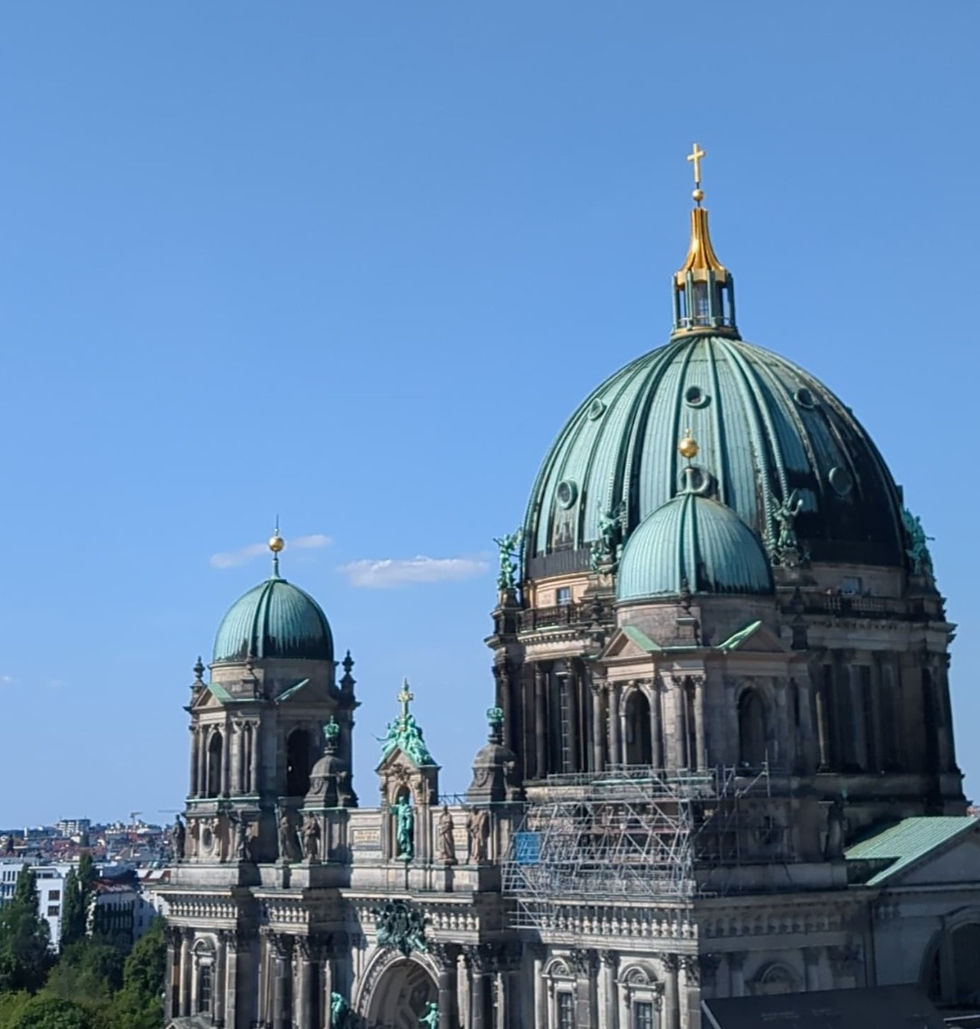Monumental Choices
- Marie Laure
- Jul 10, 2023
- 4 min read
The Saturday Farmer's Market right outside my apartment in Berlin brings people from the neighborhood together in a spirit of "joie de vivre". The cafe lined street with choice ethnic restaurants is a mecca any day of the week. People here are living the "good life". A young woman with arm outsretched standing inside her "strudel stall" tempted me with her home-baked delight. Of course, I couldn't resist spending four euros to have a slice of Germany's version of apple pie. She couldn't resist asking "Where are you from?" that ubiquitous question after hearing my "guten Morgan" and "Danke Schoen", a dead giveaway. I followed up with this bright-eyed woman the age of my daughter, who was then celebrating her 32nd birthday this very day in the States. I asked, "Are you from Berlin?" She pointed to the place where she was standing and said she had grown up "right here, on this street." I asked "Has it changed much?" "Oh yes! All the buildings used to be gray. There was nothing here before the wall came down. My parents have a picture of me when I was four years old on my bike and there were only three cars on the street." She understood that I was a transient passing through her world that had seen so much change in her short lifetime. There was no way for outsiders to understand this painful legacy that has risen up from the ashes like a phoenix. Yet, the markers are everywhere in the many monuments that overpower the landscape.
For a place that was bombed out, the past still stands, in part because the zoning laws of "reunification" construction, that continues thirty-four years after the wall came down, calls for old facades to be maintained wherever possible. This creates an unusual dichotomy both architecturally and symbolically, especially if the original place itself symbolized the worst oppressors: men who controlled the populace through sheer willpower going back centuries. One of the most recently opened (twenty years in the making) is the former City Palace renamed the Humboldt Forum after the geographer and explorer, Alexander von Humboldt. The outside was maintained right up to its gold cross atop the dome that can be seen for miles. Not all Berliners agreed with the choice to allow the former Prussian kingdom's wealth, never shared with the people, to be restored to its opulence as a showpiece monument. To counteract this choice, the gutted palace has become museum space housing collections acquired from around the world. Talk about adding insult to injury! Nobody denies the controversial nature of such choices. The "forum" is meant to be a culturally diverse place for open discussion and debate. Some call it part of the healing that needs to happen here. I hope it will function in some way that does more than glitz over the real damage that was done to innocent people. I cannot help but think about the monuments in my own backyard that have been lightning rods rather than soothing balms.
Most recently in St Augustine, Florida, the city government voted to remove from the central plaza a monument that had stood in that place for decades. It was commissioned long ago by the Confederate mothers in honor of their fallen sons in the Civil War. The proposed removal prompted fury by some and delight by others. The monument was a symbol of all that the South had fought and died for, namely, slavery and its preservation. The plaza itself is no more than a small rectangular piece of geography that has its own violent history. Reverend Martin Luther King and local black people walked peacefully through the square after King called St. Augustine "The most racist city in America." He was jailed when he sat at a local lunch counter. Years later, the Mayor of Atlanta, Andrew Young, followed in those footsteps and was severely beaten in the plaza. The monument was standing tall through it all. It is not a stretch of the imagination to think who might have perpetrated the violence against these black men years after that monument was placed there. When it was decided to take it from there and relocate it outside the historic district, threats of violence were hurled once again. The weeks-long dismantling required tight security. Those monument movers were called from other Southern states where monuments had been removed to do the same dangerous work where I lived. Their lives were threatened. In the end, the monument was moved under cover of night by boat on the river rather than through the city streets in order to protect the movers.
The choices to move a monument from view or to reconstruct a monument to its glory are flip sides of the same coin. It makes me wonder about the deeper intrinsic value we have placed on these stone symbols. Why do we feel so viscerally attached or disgusted by them? Why do we step outside our comfort zone to support or protest the outcome of a choice made long ago by others? Every country has its monuments, like its own version of apple pie. It says something about pride of nationality and country to share your strudel with a foreigner. Is the choice to save a monument so important or, is it as simple as apple pie?


Comentarios